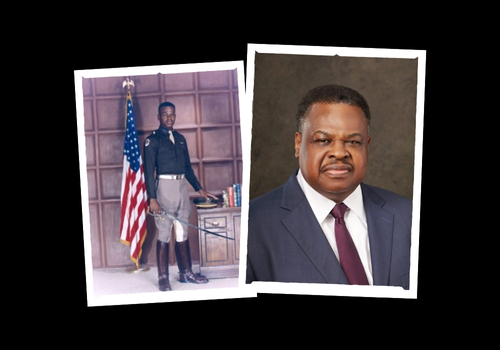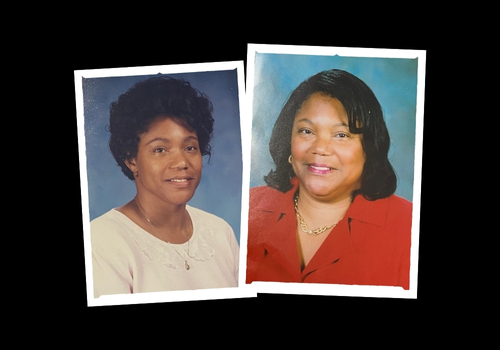Captain Ernest Ray Hunter, Sr. is a highly decorated and distinguished retired Naval Officer and Facilities Management Professional. He is a proud member of the Texas A&M Class of 1972. Born and raised in Bryan, Texas, he graduated from E.A. Kemp High School in 1968, a pivotal time a few years before desegregation and the school's closure. A high school honor student and president of his class, he was actively involved in both the concert and marching bands, along with various clubs.
Growing up less than twenty miles from the Texas A&M University campus, he never imagined being able to attend the then mostly racially segregated institution. Encouraged by an extremely dedicated and persistent high school guidance counselor, Captain Hunter applied to Texas A&M University—a decision that would change his life. Leaving his job as a mail clerk trainee at the U.S. Department of Agriculture building on the A&M campus, he was accepted to Texas A&M in 1968. With a strong academic background in science and mathematics, he chose electrical engineering as his field of study, graduating in 1972 with a bachelor’s degree in electrical engineering.
To finance his education, he used student loans and worked at Texas Instruments in Dallas, Texas as a co-op student, as well as served as an engineering aide at Union 76 Oil Company in California for two summers. Prior to graduation, he was drafted into military service. However, thanks to the service college deferment program and the U.S. Navy delayed entry program, he completed his degree and worked as a permanent employee at Union 76 for six months before enlisting in the Navy. With a guaranteed commitment of reemployment by Union 76 upon completion of military service obligation Captain Hunter started his military service with the intention of completing his four-year obligation and returning to work for the oil company.
While in boot camp, Captain Hunter discovered the Naval Mobile Construction Force (Navy SEABEEs) which is led by a small cadre of Navy Civil Engineer Corps officers and was inspired to apply to the Navy Officer Candidate School in Newport, Rhode Island. He was commissioned as an Ensign in the Navy Civil Engineer Corps in 1973 after briefly serving as an enlisted Electrician Mate Third Class with Naval Coastal River Squadron-Two in Little Creek, Virginia supporting PT boats and other costal combat crafts.
Captain Hunter's first assignment as a commissioned officer was as a Shops Engineer at the Naval Weapon Support Center in Crane, Indiana, where he led the civilian workforce supporting complex facilities for weapon production. After two years and a promotion to LTJG (O-2), he became the Public Works Officer at the Naval Security Activity Base, Skaggs Island, California, heading up the facilities department for the entire base.
Recognized for his leadership potential, the Navy selected him to return to Texas A&M for his master’s degree in electrical engineering. Upon graduation, he served as Bravo Company Commander in Naval Mobile Construction Battalion 133 (NMCB-133), overseeing overseas construction projects and facilities maintenance.
Throughout the remainer of his 26-year career, Captain Hunter held many significant positions, including serving as the World-wide SEABEEs Assignment Officer at the Naval Military Personnel Command in Washington, DC, and as Special Project Officer for a world-wide facilities management automation project at the Naval Facilities Engineering Command Headquarters in Alexandria, Virginia. He also served as the Executive Officer (second in command) of the Naval Construction Training Center in Gulfport, Mississippi, and was a student at the Armed Forces Staff College in Norfolk, Virginia. Additionally, he held the role of Public Works Officer (Chief Facilities Officer) at Naval Ordnance Station in Indian Head, Maryland, and was the Deputy Public Works Officer (Deputy Chief Facilities Officer) at Naval Submarine Base in Kings Bay, Georgia.
After his Kings Bay assignment, he attended the Industrial College of the Armed Forces in Washington, DC, earning a master’s degree in National Resources Strategy with a focus on Telecommunication & Information Systems. Rising to the rank of Captain (O-6), he served under a rare special assignment as Deputy Assistant Secretary of Energy for the Naval Petroleum and Oil Shales Reserves at the Department of Energy (DOE). Notably, in 1995, he co-founded the HBCU Internship Program offering STEM related internship opportunities for historically excluded college students. The program has since evolved into the DOE Mickey Leland Energy Fellowship program, celebrating over 34 years and more than 1,000 graduates.
Captain Hunter concluded his naval career as Commanding Officer of Engineering Field Activity West in San Bruno, California, where he managed a $200 million annual construction program and led a team of 550 personnel supporting five major military bases and many Reserve centers.
After retiring from the Navy in 1999, he was appointed Assistant Director for Facilities Services at the University of Texas at Austin. He quickly advanced to Director of Physical Plant, overseeing a budget of over $50 million annually and managing a workforce of 1,000 across two campuses.
After retiring from UT Austin in 2007, Captain Hunter founded Hunter Consulting and Training, helping higher education facilities management organizations in enhancing their operations. Now fully retired as of 2023, he enjoys life with his wife, Brenda, of 51 years. Their family proudly continues the Aggie legacy, with their son Ernest Hunter II, daughter Britney Hunter, and daughter-in-law Shannon Hunter who are also Texas A&M graduates.











![[ photo by JP Beato III ] http://www.jpbeato.com [ photo by JP Beato III ]
http://www.jpbeato.com](https://tamubfsn.org/wp-content/uploads/2024/12/20241109_AIG_0274-1024x683.jpg)
![[ photo by JP Beato III ]
http://www.jpbeato.com [ photo by JP Beato III ]
http://www.jpbeato.com](https://tamubfsn.org/wp-content/uploads/2024/12/20241109_AIG_0228-1024x683.jpg)
![[ photo by JP Beato III ]
http://www.jpbeato.com [ photo by JP Beato III ]
http://www.jpbeato.com](https://tamubfsn.org/wp-content/uploads/2024/12/20241109_AIG_0224-1024x683.jpg)
![[ photo by JP Beato III ]
http://www.jpbeato.com [ photo by JP Beato III ]
http://www.jpbeato.com](https://tamubfsn.org/wp-content/uploads/2024/12/20241109_AIG_0212-1024x683.jpg)
![[ photo by JP Beato III ]
http://www.jpbeato.com [ photo by JP Beato III ]
http://www.jpbeato.com](https://tamubfsn.org/wp-content/uploads/2024/12/20241109_AIG_0208-1024x683.jpg)
![[ photo by JP Beato III ]
http://www.jpbeato.com [ photo by JP Beato III ]
http://www.jpbeato.com](https://tamubfsn.org/wp-content/uploads/2024/12/20241109_AIG_0181-1024x683.jpg)
![[ photo by JP Beato III ]
http://www.jpbeato.com [ photo by JP Beato III ]
http://www.jpbeato.com](https://tamubfsn.org/wp-content/uploads/2024/12/20241109_AIG_0176-1024x683.jpg)
![[ photo by JP Beato III ]
http://www.jpbeato.com [ photo by JP Beato III ]
http://www.jpbeato.com](https://tamubfsn.org/wp-content/uploads/2024/12/20241109_AIG_0153-1024x683.jpg)